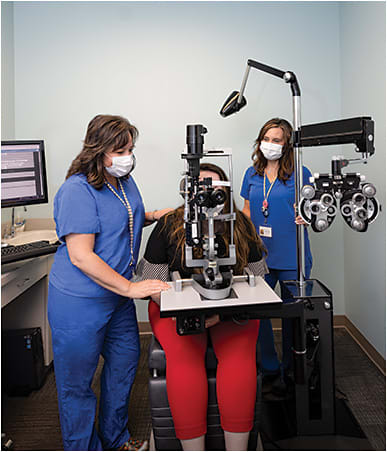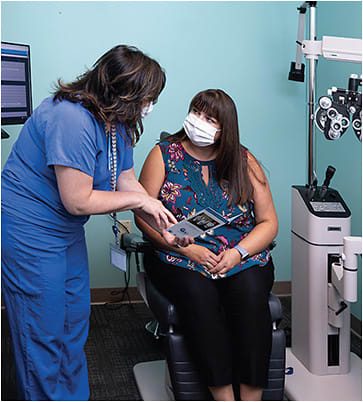PHOTOGRAPHY BY HEIDI KIRN PHOTOGRAPHY

In 2021, Eyecare Medical Group (EMG), a two-location (Portland and Saco), 35-year-old ophthalmology practice in Maine, converted to an Employee Stock Ownership Plan. The plan, which gives employees ownership interest in the practice, exemplifies the practice’s organizational culture, which EMG’s Chief Executive Officer John Wipfler, JD, MBA, credits for the practice’s continuous growth. (See “Organizational Culture: An Overview,” p. 13.)
“Organizational culture is the foundation for all that we do. It arises from our values and defines who we are, how we do things, and creates the norms about how we treat each other,” he explains. “We have built a culture that has high trust, a strong teamwork ethos, and transparency. This leads to both high-staff engagement, because their voices are heard and respected, as well as an excitement about coming to work. These characteristics have motivated staff to go above and beyond to ensure patients are as happy as they are, which, in turn, creates word-of-mouth referrals and continuous practice growth.”
In fact, the practice recently hired an additional 21 staff members and foresees adding more employees.
Here, members of the EMG retina staff discuss the action steps the practice’s leadership has created to inculcate the organizational culture that has led to its growth.
1. Shadowing teammates
Aaron Parnes, MD, a specialist in retinal detachment and general retina at the practice, says EMG’s leadership infuses its organizational culture by having new hires shadow experienced staff (i.e., allied health staff, as well as doctors). This way, he says, they can see how they are expected to interact with each other and with patients.
“When it comes to macular hole surgery, for instance, I’ll briefly explain to the patient what that entails and how much vision they can expect post-operatively, but our technicians go into detail with the patient about what they can expect before, during, and after surgery, and they invite questions,” Dr. Parnes says. “They patiently provide this one-on-one education to patients because this is how the seasoned techs treated them and the patients they saw during the shadowing.”
“The leadership at EMG truly want us to learn,” adds Dennise Boyce, a surgical ophthalmic technician. “They want us to know why we’re doing what we’re doing and how to do it better. This makes us feel like we’re part of a team vs. a new employee who’s more or less expected to figure it out on their own.”


2. Getting the lay of the land
Another way the practice’s leadership instills EMG’s organizational culture is by making sure everyone is familiar with all areas of the practice, should an extra hand be needed in a particular section, says Cheryl Estrella, the practice’s Retina Drug Program specialist.
“I am one of two who coordinate the copay assistance programs for patients who need intravitreal injections, such as Eylea (Regeneron), Lucentis (Genentech), and Vabysmo (Genentech), among others, but I’m also a trained optician, so I am able to cover for someone in the optical dispensary if needed,” she says. “Cross-training sends the message to all staff members that we work as a team here, squashing the ‘that’s not my job’ attitude from day one.”
Ms. Estrella adds that having an understanding of everyone’s main job garners both respect and empathy, which fosters the team mentality that is integral to EMG’s organizational culture.
3. Seeking suggestions
Darrin Landry, EMG's Diagnostic Imaging Department manager, says that leadership imparts the organizational culture by both inviting and seriously considering every staff member’s input. He notes that EMG’s doctors, including its three retinal specialists — Dr. Parnes, Jackie Nguyen, MD, and Scott Steidl, MD — actively seek suggestions regarding new technologies as well as how to best utilize what is in use.
“If I feel there is a new technology that could benefit patients, they value my opinion,” he says. “For example, I think we were one of the first practices in the country to purchase an OCT angiography (OCT-A) device. We acquired a system right after its FDA approval, because I made a case to the physicians that non-invasive OCT-A would be another diagnostic tool that would benefit diagnosis and patient flow. We are able to identify choroidal neovascularization and diabetic retinopathy changes in a quick, reliable and repeatable method now.
ORGANIZATIONAL CULTURE: AN OVERVIEW
Organizational culture is an organization’s shared beliefs and values that are created by its leaders and then communicated and buttressed via an array of methods, such as staff meetings, to shape the staff’s perceptions and behaviors, according to the Society for Human Resource Management. What’s more, successful organizations have leaders dedicated to “living” this established organizational culture daily, consistently providing clarity on the organization’s values and how those values set the tone for how the organization runs.
“For any organization, one of the primary responsibilities of leadership is the intentional development, monitoring, and shaping of organizational culture,” says Mr. Wipfler. “Culture develops whether we attend to it or not, so intentionality is critical.”
“I stay up to date with clinical trials and look at all the new studies coming out, and we talk about them as peers,” he explains. “That’s not a typical relationship between staff and physicians, but it’s a universal way of thinking here.”

Ms. Estrella says her position is a “prime example” of how the practice’s leadership listens to staff.
“Up until five years ago, the techs were overseeing the copay assistance programs, along with their other duties, and the workload was just too much. I was a tech in retina, so I experienced this,” she remembers. “The techs brought this issue to the practice’s leadership, and they created two new positions to exclusively oversee these programs. These positions have benefited both the retina techs and our patients, who depend on these drugs to maintain their vision.”
EMG leadership further seeks the opinions of its allied health staff by involving them in the hiring process, offers Mr. Landry.
“We actually get to interview the physicians to see whether we think they fit the practice’s organizational culture!” he exclaims. “I think at first the ophthalmologist candidates are kind of surprised by that, but they realize quickly that this is how it is here; everyone has a hand in this.”
Ms. Boyce says she likes to provide scenarios to job candidates during an interview to see whether they’d fit in with EMG.
“I like to ask, ‘If you were to have a 35-patient day and you were running behind, what would you do to help the day go better?’” she explains. “I first look for the doctor’s reaction, and then listen for how they would treat the staff. There are going to be times when we’re behind, so we want someone who’s going to be a calm problem solver.”
Mr. Landry adds that staff meetings are designed to be transparent to create an environment where staff can feel comfortable asking questions.
“Staff meetings usually include a PowerPoint presentation, and there is always a question-and-answer portion where new hires are told, and veteran staff are reminded, that no question is judged,” he points out. “A staff advisory committee, comprised of staff who advise the practice’s doctors and leadership on staff issues, was recently created at one of these meetings, so the leadership isn’t just asking our opinion. They’re saying, ‘We want a whole committee to form, so that you can come to us with problems that we may not be aware of.’”
For instance, one staff member suggested implementing timed lights outside the exam rooms.
“When a tech instills anesthetic drops for an intravitreal injection, they activate the light, which changes color at timed intervals and alerts the technicians if the patient needs another set of drops,” Mr. Landry explains.
For staff members tentative about asking questions, EMG has a whiteboard in a private area of the main practice, where inquiries can be written and then broached during the next staff meeting, Ms. Boyce explains.
EYECARE MEDICAL GROUP AT A GLANCE
- Founded: 1987 by Elizabeth G. Serrage, MD, William S. Holt, MD, and Bruce R. Cassidy, MD.
- Practice specialties: Cornea, cataract, dry eye disease, glaucoma, oculoplasty, retina, refractive surgery, an optical shop, and an ambulatory surgery center (ASC) with 4 operating rooms. The ASC is attached to the practice's Portland facility.
- Doctors: 10 MDs, 1 OD
- Allied health staff: 130, including ASC personnel.

4. Showing appreciation
Ms. Boyce says EMG leadership infuses the organizational culture by actively showing allied health staff their appreciation. In fact, at the time of this interview, an ice cream social had just taken place at the practice.
“I walked by the area after the ice cream social ended, and there was our CEO cleaning up in the kitchen,” she says. “You know, that’s not something anyone would expect to see, but here, it’s different. We really are all in this together.”
To remind staff of their value, Ms. Estrella says that the leadership sends company-wide emails containing patient compliments.
“That’s so encouraging, especially when you’re in the middle of a busy day,” she notes.

Taking stock in what matters
Mr. Landry says he’s thrilled about the Employee Stock Ownership Plan, in which EMG will go through an annual financial valuation process, and stock prices will be reset according to each valuation.
“I’m excited about having some skin in the game,” he says. “Being part of the process that has enabled the practice to succeed has been exciting, and it’s obviously going to continue to be a part of everything I do here.” OP








